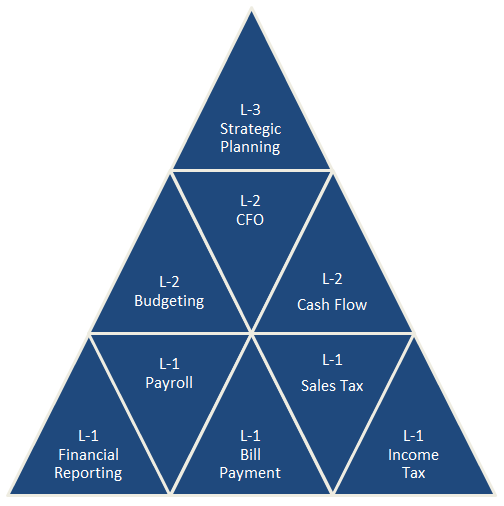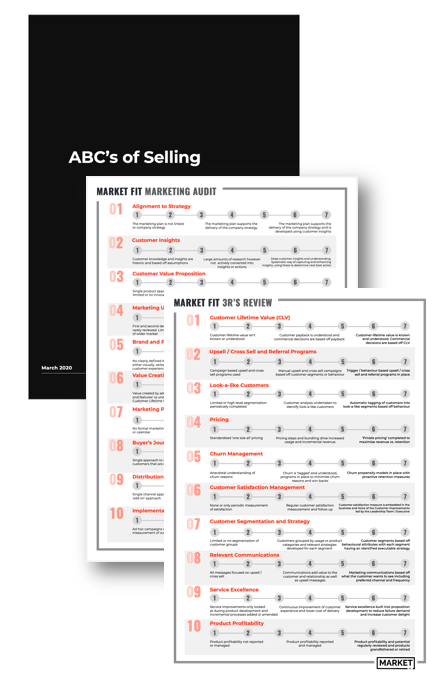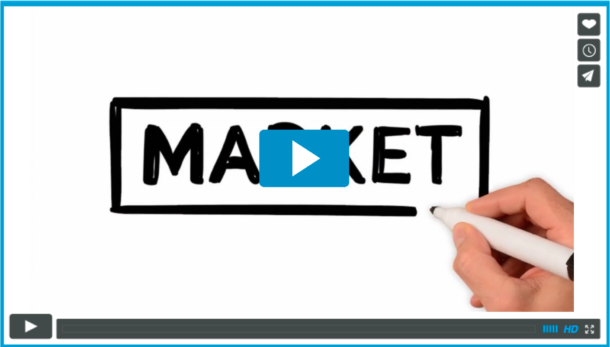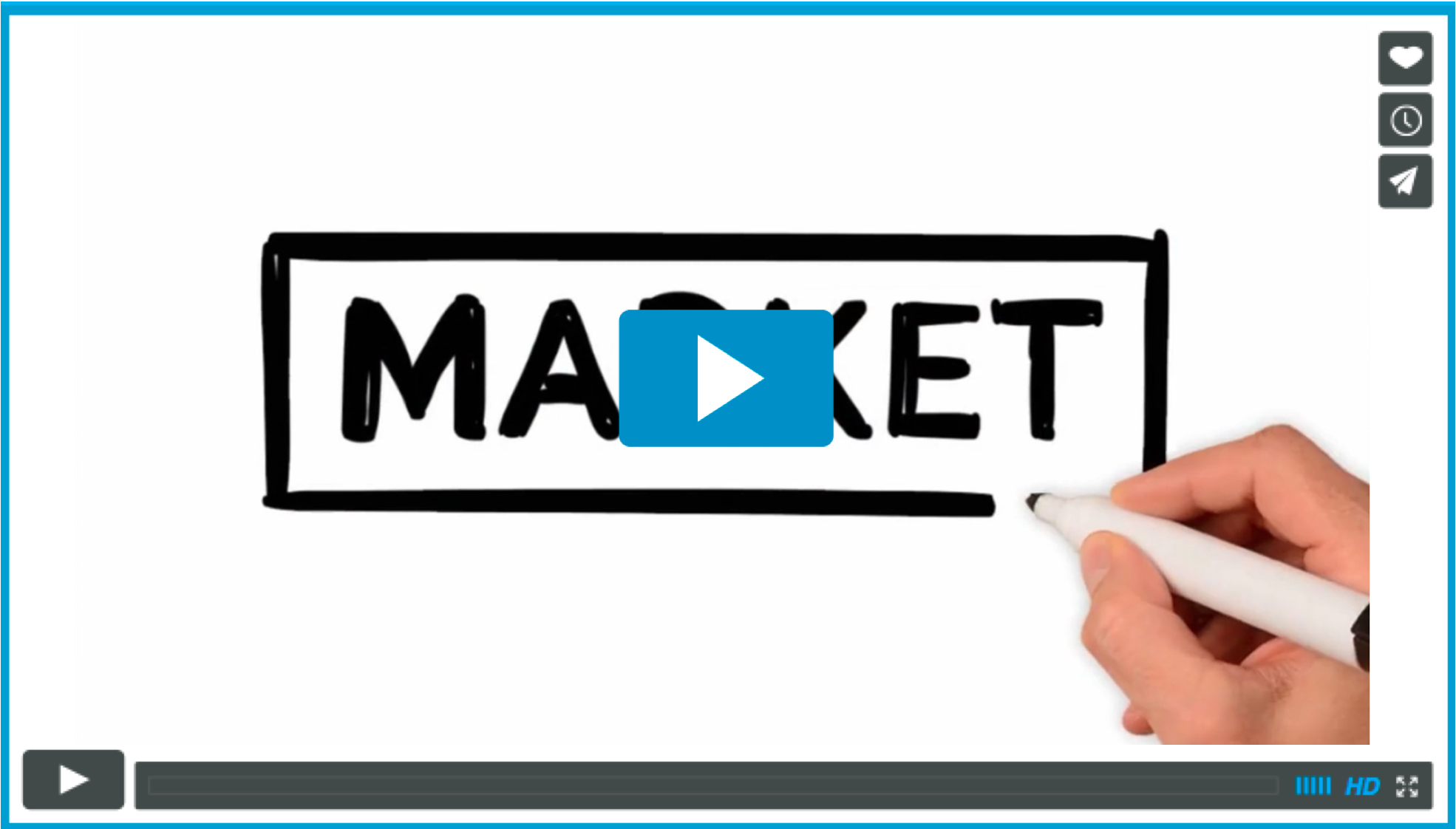This post is written in the context of an Accounting professional however it can be applied to any professional services business.
Accounting professionals come in many different forms, from the lowly self-taught bookkeeper, who does the books of the local small businesses, right up to highly paid professionals who consult to multinational corporations.
No matter how different these professionals are, they all conform to the three basic levels of accounting service, namely, compliance, performance monitoring and strategy. The lower level 1 bookkeepers tend to confine their services to compliance only. This would entail all the data capturing, bank reconciliations and compliance with tax requirements, submitting returns etc.
Most level 2 practices combine compliance with performance monitoring and include functions like cash flow projections.
The professionals at the top of their game at level 3 do very little compliance and performance monitoring work, as this is normally done by the corporation they are consulting for; but rather they are almost exclusively engaged in strategic planning, usually for healthy remuneration packages. This is the value chain, and moving up should be a priority.
An educated guess would say that 80% of your revenue is from L1, yet 80% of your profit is from L2/L3.

Pricing
From time immemorial, accountants, and many other professionals, such as doctors and lawyers, have worked and charged their clients on a time based pricing structure. The time-based pricing structure is conventionally seen as number of hours worked x rate per hour.
Recently, however, there has been a move from time based pricing structure to a value-added pricing structure, in which the professional charges what he perceives the value of his service to the client will be. We will deal with this aspect in more detail in another article.
Changing Paradigm
In the past, the vast majority of level 1(compliance) practitioners were extremely process driven. These processes were very much time driven and were charged accordingly. Now, however, with the emergence of new technologies like cloud based software utilisation, and, remember this is one of the threats we identified in an earlier article; these processes, which used to take days, now take a matter of hours.
This has an upside and a down side. The downside is that the need for your compliance only, time-based services, are in less and less demand with more and more supply, which will result in a continuous decline in your revenue stream. The upside is the free time created, which will allow you to start offering level 2(performance monitoring) and level 3(strategic planning) to your existing clients, and a way for you to capture new clients on a much more professional basis.
Another positive advantage of the cloud based technology is that it gives you access to very sophisticated software, which allows you to provide real time performance monitoring tools and, more importantly, the tools required for you to offer important strategic advice. This, in essence, is moving up the value chain.
3 Levels of the Value Chain
Let’s look now in greater detail at the 3 levels of the value chain. It is important to realise that each level attempted requires a greater level of expertise and experience to be able to provide the client with a decent value based service.
Level 1: Compliance
As stated earlier, level 1 is very much process and time driven and is the more conventional approach favoured by the vast majority of accounting or bookkeeping practices. Level 1 service includes, but is not exclusive to, financial data capture, payroll, debtor and creditor payments and sales and income tax compliance.
Nowadays, the advances in cloud computing are making many of these tasks obsolete, and together with automated government tax returns, will lead to more and more of these functions being done effortlessly by the clients themselves, at a fraction of what they used to cost. This will lead to a decrease in the revenue streams of the firms that specialise in these services and, maybe eventually, the subsequent demise of these narrowly specialised practises.
Level 2: Performance Monitoring
With the advent of cloud based technologies, the ability to provide these value added services, has become more affordable to the small practice, but also more accessible, without the considerable outlay for expensive software.
Cloud based computing allows the practitioner to access clients software and accounts remotely providing assistance, reporting and commentary. Typically, level 2 service relates to slightly more sophisticated processes such as budgeting and cash flow projection.
Level 3 Strategic Advice and Planning
Most practises who offer these services, also perforce offer performance monitoring, as most of the decisions at level 3 are predicated by information deriving from level 2 services. Level 3 can be seen as the pinnacle of the accounting profession, as you are then trusted sufficiently by the client to offer input on the top level management decisions as to the strategic direction the client intends undertaking. These services include strategic planning, succession plans, chain of command structures and risk management.
It must be emphasised at this point that each step upwards demands a greater level of expertise and a greater level of trust between you and your client. If you do not have the skills, don’t offer the service. There is no quicker way to kill your business than to offer ill-considered advice that has potentially disastrous consequences.
Moving up
Now that we have examined the three levels, let’s take a look at how you can facilitate your movement upwards from one level to another. This movement is dependent on putting various systems and processes into place.
A lot of accounting practices are smaller operations and unfortunately while great technically are typically not good salespeople. The key to moving up the value chain is to determine what you can offer and who you need to implement these offerings. So, although you are in a position to offer extra services, you might not be the correct person to sell these services to existing and new clients. Let’s look at all the elements in more detail.
What Can I Offer?
Too many accounting practitioners stick with the level 1 services, but the companies you deal with, and this includes not-for-profit organisations, need extra services such as staff development, team building, technology and budgeting.
Are you in a position to offer these services? Look carefully at what you offer at the moment and try and add value added services, which you are already competent to provide. This is called bundling, and we will deal with it in more detail in Article 3.
Forecasting and budgeting, for example, is one of the added value services that any average accounting professional can accomplish without any extra training, but is also a function that scares the living daylights of the average owner of a small business. This service would be extremely easy for you to offer as a value added service, and your clients will be thankful for your guidance in developing effective budgets that facilitate financial planning and monitoring activities.
Your communication and listening skills will be of considerable importance. You need to be able to listen actively to what your client is telling you about his or her business, plans for the longer term, and shorter term goals for the financial year. You will need to ask questions, explain concepts, and help your client to “own” the budgets you draw up.
Do I Have the Team?
Moving up the value chain requires a delivery team approach. In this approach, it would not be possible for you to provide all the services yourself, so you would have to hire people to provide the platform that enables you to offer these extra value added services.
Many small accounting businesses would balk at taking on the extra overhead, but don’t forget that you can contract most professionals on a part time or freelance basis.
This would be part of the bundle, priced appropriately, that you sell your client. Once the client is on board, you would ideally follow up with constant client service liaison to build and cement the client’s perceived value in your product. Get to know your existing employees and think laterally to utilise all of their abilities. Your receptionist, for example, might, with a little training, make an excellent client liaison. Build Value.
What’s Different about My Product?
Each accounting practise develops in a unique way of doing things, and this is generally as the result of your client base. If you mainly service small businesses in a small town, you have to start thinking out of the box. What other areas can I explore to increase my client base? What unique way do I have of doing things that I can adapt to suit new clients?
Start to document these unique processes, to ensure an ongoing record of how things are done in your practice, and a smooth transition to a dynamic practice that has taken into account the many issues that plague small businesses, such as: chain of command, staffing, pricing, technology and regulations. If you are going to switch to cloud based accounting, for example, who will research the many products on offer? Who will undertake to implement the new systems? By when will they be implemented? How do you seamlessly link the cloud solutions together for a customer, giving them an end to end view of their business/
What Do I Charge?
Pricing is the most critical aspect when contemplating taken your practice in a different direction. It requires thought to determine the right price for any particular bundle, and sales skills to sell that bundle, at that price, to a potential client.
Unfortunately accountants generally don’t make good sales people, and should concentrate rather on the delivery of the services. People with sales skills should be the ones to engage directly with the client and negotiate the range, or bundle, of services to offer and the terms under which the contract is to be fulfilled. Payment terms, for example: to take the time to question the client about their needs and concerns, and engage in constant follow up, will give you a deeper understanding of what to offer, and provide the opportunities for further expansion of your services to that client.
If you want to move up the value chain, you need to take a leap of faith to push your practice in a new direction, and this takes lots of courage. But, it also creates a very liberating feeling of entering a whole new, exciting dimension for your business.
Many accountants only tell their clients what to do and not why it’s important. You add value by getting your clients to understand the “why”, and then guiding them in implementing your products to assist with problem-solving and future developments. At the moment, you are a technical advisor. What you need to do is feed off the natural trust most people have in their bookkeepers, and become a trusted business advisor.
Rewards for you and for your clients
Many accountants don’t perceive this trust and utilise to their advantage. The traditional number crunching level 1 service is fast becoming obsolete, opening up the way for you to become a trusted advisor to steer your clients into a profitable and stress-free future. The task might appear to be daunting, but you will reap rewards, not only in increased revenue, but in the rejuvenation of your practice and, tackling the added challenges of taking your practice in a new direction.
Best of all, you’ll have the added satisfaction of knowing that you really are adding value in real terms to your clients’ businesses. They need your knowledge, and they want what you have to offer. You will lead them through tough business decisions that might otherwise have paralysed them, helping them to achieve their vision for their businesses. That’s the ultimate value-add!




